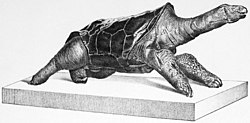Saddle-backed Rodrigues giant tortoise
| Saddle-backed Rodrigues giant tortoise | |
|---|---|
 |
|
| Stuffed specimen | |
| Scientific classification | |
| Kingdom: | Animalia |
| Phylum: | Chordata |
| Class: | Reptilia |
| Order: | Testudines |
| Family: | Testudinidae |
| Genus: | Cylindraspis |
| Species: | C. vosmaeri |
| Binomial name | |
|
Cylindraspis vosmaeri Suckow, 1798 |
|
| Synonyms | |
|
|
The saddle-backed Rodrigues giant tortoise (Cylindraspis vosmaeri) was a species of giant tortoises in the Testudinidae family. It was endemic to Rodrigues. The human introduction of predators and hunting pressures are believed to have caused the extinction of this species roughly around 1800.
Both the saddle-backed tortoise, and its smaller domed relative, were descended from an ancestral species on Mauritius (an ancestor of Cylindraspis inepta), which colonised Rodrigues by sea many millions of years ago, and then gradually differentiated into the two Rodrigues species.
The saddle-backed Rodrigues tortoise was an exceptionally tall species of giant tortoises, with a long, raised neck and an upturned carapace, which gave it a giraffe-like body shape almost similar to that of a sauropod dinosaur.
It lived by browsing the taller vegetation, while its much smaller relative, the domed Rodrigues giant tortoise, grazed on low vegetation such as fallen leaves and grasses.
The saddle-backed tortoise was described by early colonists as a docile, gentle browser, with a tendency to gather in large herds, especially in the evening. An early Huguenot settler, in 1707, described the unusual group behaviour of these animals:
"There's one thing very odd among them; they always place sentinels, at some distance from the troop at the four corners of the camp, to which the sentinels turn their backs, and look with their eyes, as if they were on watch. This we have always observed of them; and this mystery seems the more difficult to be comprehended, for that these creatures are incapable to defend themselves..." (Leguat, 1707)
It has subsequently been discovered that the browsing herds of tortoises filled an essential role in the island's ecosystem and the regeneration of its forests. Among other roles, the tortoises ensured the dispersal and germination of the trees' seeds, as well as "terraforming" by maintaining forest clearings and pools.
In recognition of this fact, measures have been undertaken to introduce replacement species, in the form of similar giant tortoises from other parts of the world, to assist in the rebuilding of Rodrigues's devastated environment. The replacement species for the saddle-backed Rodrigues tortoise was chosen to be the Aldabra giant tortoise (Aldabrachelys gigantia) of the Seychelles, which is roughly similar in size, though very different in body form.
...
Wikipedia

